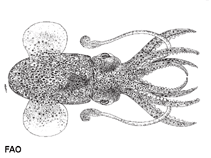Sepietta oweniana (d'Orbigny, 1841)
Common bobtail squid| Native range | All suitable habitat | Point map | Year 2050 |

|
| This map was computer-generated and has not yet been reviewed. |
| Sepietta oweniana AquaMaps Data sources: GBIF OBIS |
Classification / Names Common names | Synonyms | CoL | ITIS | WoRMS
Cephalopoda | Sepiida | Sepiolidae | Sepiolinae
Environment: milieu / climate zone / depth range / distribution range Ecology
Benthopelagic; depth range 42 - 701 m (Ref. 114857), usually 120 - 200 m (Ref. 843). Temperate; 70°N - 16°N, 18°W - 37°E (Ref. 106954)
Distribution Countries | FAO areas | Ecosystems | Occurrences | Introductions
Eastern Atlantic, the Mediterranean and Western Indian Ocean: from Norway to Mauritania and the Indian Ocean.
Length at first maturity / Size / Weight / Age
Maturity: Lm ? range ? - ? cm Max length : 5.0 cm ML male/unsexed; (Ref. 3722); 4 cm ML (female)
An epipelagic-mesopelagic species, occurring within a wide depth range, from close to the surface (8 m) down to over 1000 m. Common depth range in the North Atlantic is between 50 and 300 m; and between 100-200 and 400 m in the Mediterranean. Prefers soft, muddy substrates, often on shrimp fishing grounds. Never found in brackish waters. Vertical movement of this species is linked to trophic relationships. Feeding occurs primarily from dusk to dawn, with adult animals spending the day buried in the bottom substrate. Feeds mainly on crustaceans, notably on euphausiids, and the decapod Pasiphaea sivado in the northern Tyrrhenian Sea. Undergoes seasonal movements related to reproduction. Spawning most likely continuous throughout the year, with reported peaks in reproductive activity in several different areas. Mating takes place head-to-head, generally in shallow coastal waters. Both viable and unviable eggs are deposited in various solid substrates, preferably on ascidians (Microcosmus). Eggs hatch in about 2 months. Its short lifecycle is range from between 6 to 9 months. Preyed upon by several demersal fish and occasionally by cetaceans. Successfully cultured in aquaria. Abundant in the Mediterranean Sea and represents an important bycatch of many trawl fisheries. Commonly sold on Mediterranean markets, most abundant in summer, and is valued as a delicacy in certain areas such as in southern Sicily (Ref. 1695).
Life cycle and mating behavior Maturity | Reproduction | Spawning | Eggs | Fecundity | Larvae
Members of the class Cephalopoda are gonochoric. Male and female adults usually die shortly after spawning and brooding, respectively. Mating behavior: Males perform various displays to attract potential females for copulation. During copulation, male grasp the female and inserts the hectocotylus into the female's mantle cavity where fertilization usually occurs. Life cycle: Embryos hatch into planktonic stage and live for some time before they grow larger and take up a benthic existence as adults.
Main reference
References | Coordinator | Collaborators
Roper, C.F.E., M.J. Sweeney and C.E. Nauen. 1984. (Ref. 275)
IUCN Red List Status (Ref. 130435)
Data deficient (DD) ; Date assessed: 30 March 2009
CITES status (Ref. 108899)
Not Evaluated
CMS (Ref. 116361)
Not Evaluated
Threat to humans
Human uses
| FishSource |
Tools
More information
Internet sources
BHL | BOLD Systems | CISTI | DiscoverLife | FAO(Publication : search) | Fishipedia | GenBank (genome, nucleotide) | GloBI | Gomexsi | Google Books | Google Scholar | Google | PubMed | Tree of Life | Wikipedia (Go, Search) | Zoological Record
Estimates based on models
Preferred temperature
(Ref. 115969): 7.1 - 15.3, mean 10.6 (based on 200 cells).
Price category
(Ref. 80766):
Unknown.



